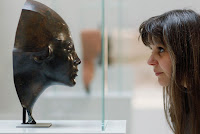Christie's employees hold a work by
British artist L. S. Lowry entitled 'Playground 1945', left, at
Christie's auction house in London, Monday, Nov. 8, 2010. The work, part
of 21 paintings drawing and etchings by Lowry who worked almost
exclusively in the north of England, is expected to sell for some
5-700,000 pounds ($800-1.1 million), when sold at auction on Nov. 11.
The sculpture that was discovered during
archaeological excavations in central Berlin and is now on display in
the New Museum in Berlin November 8, 2010. The sculpture entitled "A
Likeness of the Actress Anni Mewes" by Edwin Scharff is one of 11 pieces
of art that were found during archaeological excavations in Berlin and
initially thought to be of ancient origin. Research revealed that the
pieces were part of the 1937 travelling exhibition "Entartete Kunst"
(Degenerate Art): a collection of art the Nazis deemed un-German or
Jewish and which they displayed in a manner that derided the works and
their authors.
The discovery of Étienne Méhul's 4th symphony proved that he invented the 19th
century romantic "cyclic" symphony two decades before his
compatriot Hector Berlioz. Berlioz was previously considered to have pioneered the form in his celebrated
Symphony Fantastique.
David Charlton, Emiritus Professor of Music at the University of London, who
discovered the lost Méhul symphony by chance in Paris, is due to attend the
London premiere on Tuesday night. It is being performed by the Orchestra of the Age of Enlightenment.
Although discovered in 1979, it has taken more than 30 years for the symphony
to be performed at a concert hall in London.



No comments:
Post a Comment